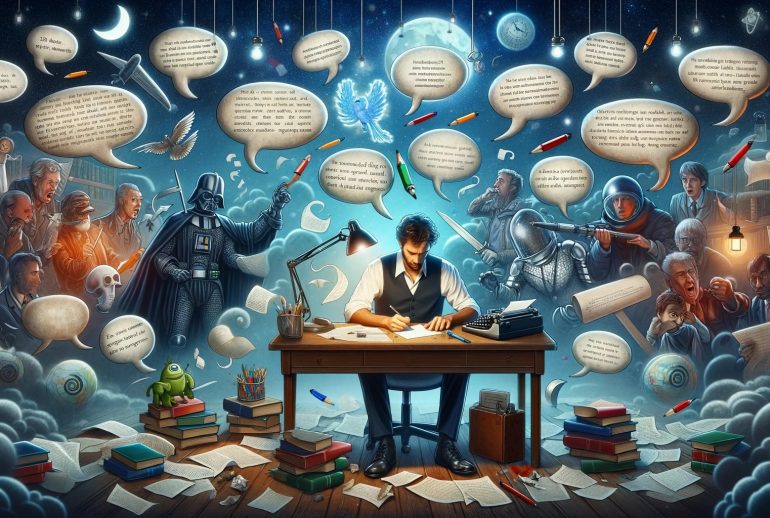Dialogue is a powerful tool in storytelling that allows readers to connect with characters, understand their motivations, and engage with the narrative on a personal level. However, writing effective dialogue can be challenging, and even experienced writers can fall into common pitfalls. In this comprehensive article, we will explore the most common dialogue mistakes and provide practical solutions to help writers create compelling and authentic conversations that enhance their storytelling.
Section 1: The Importance of Authentic Dialogue
1.1. The Role of Dialogue
Dialogue serves several crucial functions in storytelling:
- Characterization: It reveals character traits, personality, and motivations.
- Plot Advancement: It moves the story forward by conveying information, conflicts, and decisions.
- Engagement: It immerses readers in the narrative, making them feel like active participants.
- Subtext: It allows for the subtle communication of underlying emotions, themes, and conflicts.
1.2. Authenticity Is Key
Authentic dialogue is essential for readers to connect with characters and become emotionally invested in the story. It should sound like something real people would say while serving the narrative’s purpose.
Section 2: Common Dialogue Mistakes
2.1. Expository Dialogue
Expository dialogue is a common mistake where characters provide information solely for the reader’s benefit, not because it feels natural within the context of the conversation.
Example: Character A: “As you know, we’ve been best friends for ten years.” Character B: “Yes, ever since we met in kindergarten.”
2.2. On-the-Nose Dialogue
On-the-nose dialogue occurs when characters state their thoughts, emotions, or intentions directly, without subtlety or subtext. It lacks nuance and can feel artificial.
Example: Character A: “I’m so angry with you right now.” Character B: “I can tell you’re angry.”
2.3. Lack of Conflict
Dialogue should include conflict, tension, or disagreements to make it engaging. Conversations that are too harmonious or devoid of conflict can feel dull.
2.4. Monologues
Long monologues, where one character dominates the conversation, can bore readers and disrupt the natural flow of dialogue.
Example: Character A delivers a three-paragraph monologue while Character B listens silently.
2.5. Overusing Dialogue Tags
Excessive use of dialogue tags (e.g., “he said,” “she replied”) can be distracting. Instead, actions and context can often convey who is speaking.
Example: Character A said, “I can’t believe this.” Character B replied, “It’s true.”
Section 3: Solutions to Common Dialogue Mistakes
3.1. Expository Dialogue: Show, Don’t Tell
Instead of having characters explicitly state information, convey it through actions, subtext, or the context of the conversation.
Example: Character A glanced at the old photograph on the wall. “Remember when we met in kindergarten?”
3.2. On-the-Nose Dialogue: Use Subtext
Allow characters to communicate their thoughts and emotions indirectly through subtext, body language, or actions.
Example: Character A clenched their fists. “You always know how to push my buttons.”
3.3. Introduce Conflict
Include conflicts, disagreements, or differing perspectives in dialogue to create tension and keep the conversation engaging.
3.4. Balance Monologues
Break up monologues with interruptions, reactions, or questions from other characters to maintain a natural and dynamic dialogue flow.
Example: Character A began speaking, but Character B interjected, “Wait, let me finish.”
3.5. Limit Dialogue Tags
Use dialogue tags sparingly and rely on character actions and context to indicate who is speaking.
Example: Character A raised an eyebrow. “Really?” Character B nodded. “Yes, it’s true.”
Section 4: Crafting Engaging and Authentic Dialogue
4.1. Listen to Real Conversations
Pay attention to real-life conversations, noting the rhythm, pacing, interruptions, and subtext. This can help you recreate authentic dialogue in your writing.
4.2. Develop Unique Voices
Each character should have a distinct voice and way of speaking. Consider their background, personality, and experiences when crafting their dialogue.
4.3. Show Relationships Through Dialogue
Use dialogue to reveal the dynamics of relationships between characters. The way they speak to each other can convey familiarity, tension, or affection.
4.4. Read Dialogue-Driven Works
Read books, plays, or scripts known for their compelling dialogue. Analyze how skilled authors use dialogue to advance the story and develop characters.
4.5. Edit and Revise
Dialogue may require multiple revisions to achieve authenticity and clarity. Review and fine-tune your dialogue during the editing process.
Section 5: Real-World Examples
Let’s examine how renowned authors address common dialogue mistakes to create engaging and authentic conversations:
5.1. “The Catcher in the Rye” by J.D. Salinger
J.D. Salinger’s “The Catcher in the Rye” features authentic and relatable dialogue. The protagonist, Holden Caulfield, speaks in a distinctive voice that reflects his teenage angst and confusion. Salinger avoids excessive exposition, relying on Holden’s narration and interactions to reveal the character’s thoughts and emotions.
5.2. “Pride and Prejudice” by Jane Austen
Jane Austen’s “Pride and Prejudice” is celebrated for its sharp and witty dialogue. The characters’ conversations are filled with subtext, social commentary, and clever wordplay. Austen uses dialogue to convey the intricacies of society and relationships in Regency-era England.
Section 6: Conclusion
Effective dialogue is a cornerstone of compelling storytelling, allowing readers to connect with characters, engage with the narrative, and explore the themes and emotions woven into the text. By recognizing common dialogue mistakes and applying practical solutions, writers can create authentic, engaging, and meaningful conversations that enhance their storytelling.
Crafting authentic dialogue requires practice, careful observation, and a deep understanding of characters and their relationships. While it may be challenging, mastering the art of dialogue can elevate your writing and make your narratives more immersive and relatable, leaving a lasting impression on your readers.



